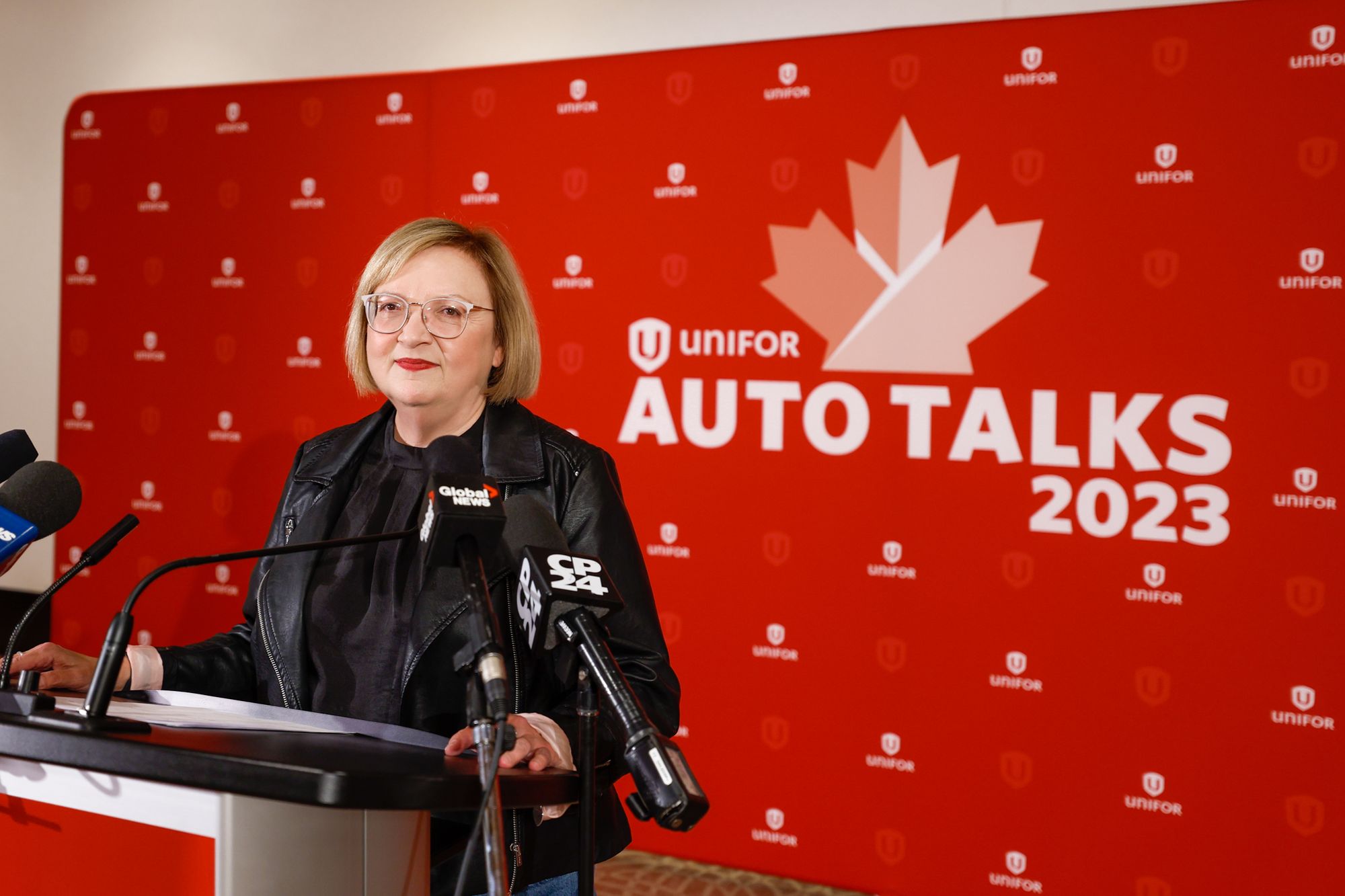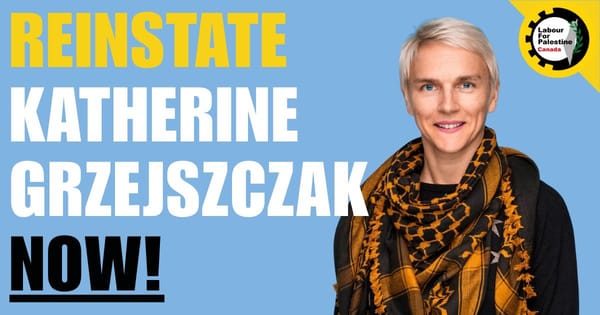
Over the past weeks, all eyes have been on bargaining and, in the United States, strikes at the “big three” automakers. Given that auto talks are happening simultaneously in Canada and the U.S., comparisons between union demands and strategies on either side of the border have been all but inevitable. That roles seem to have reversed, with the formerly conservative United Auto Workers (UAW) taking a more militant stance and Unifor appearing traditional and reserved in its approach, makes such comparisons all the more interesting.
While the UAW under new reform president Shawn Fain broke from tradition and chose to bargain with all three major American automakers at once, Unifor went the traditional “pattern bargaining” route of selecting a lead firm — in this case, Ford — and later attempting to replicate the Ford contract with General Motors (GM) and Stellantis.
The UAW strategy was and is intimately tied to its strike preparation, and now, job action. The UAW, like the U.S. Teamsters before them, has been mobilizing its members for strike action since Fain and his allies narrowly won the union leadership. The American auto union, with a much deeper legacy of givebacks and concessions to employers than the Canadians, faced a consequently larger battle. A new orientation was required if it was going to make significant bargaining improvements and win back what has been lost over the past decades.
The result is the current “stand-up strike” strategy, whereby the union selectively strikes at different employers’ production sites according to how bargaining is progressing (or not) at the table. While innovative and proving quite effective, in effect the stand-up strike ends up looking much like an iterative process of pattern bargaining. Strategically placed and timed strikes move one employer on an issue or a set of issues in bargaining, which the union will then seek to apply to the other two firms.
By contrast, in Canada, Unifor reached its deal with Ford on September 19, after extending bargaining for 24 hours and narrowly avoiding a strike. Indeed, it appeared from the initiation of bargaining with Ford that Unifor was committed to avoiding job action. Nevertheless, after resistance from GM, the union then struck the latter firm on October 10, but reached a tentative agreement just 12 hours later. Members at GM will now vote on roughly the same deal secured at Ford in Canada. How things will unfold at Stellantis are uncertain.
While union leadership characterized the pattern agreement struck with Ford as “life-changing,” there was noticeable dissension and criticism from both members and commentators. Comparisons with the seemingly bolder demands of the UAW were widespread and were surely expected by Unifor’s leadership.
It’s important to keep two things in mind, however. First, the UAW’s contracts with the U.S. automakers are very different from those between Unifor and the companies. American auto workers surrendered past gains on wages, pensions and employment security much earlier than Canadians (in fact, such concessions motivated the Canadian section to leave the UAW in the 1980s). Consequently, across job classifications, American auto workers make lower wages than Canadians. The UAW thus had a much steeper hill to climb, and not only on wages. The American union’s bold demands must be placed in this historical context to be fully understood and appreciated.
Second, demands are one thing, final contracts are quite another. We can assess the strategies and progress of Unifor and the UAW as the bargaining and strike processes unfold, but a final accounting is only possible when both have ratified new collective agreements with all three companies. Many Canadian union members and labour commentators are understandably inspired by the new leadership at the UAW and hoping for a positive outcome from its current job action, myself included. But at this stage, most of what we have from the UAW are demands.
The Unifor-Ford Contract
Unifor characterized the deal in its master bargaining report this way: “This three-year deal meets the extraordinary moment we are in. It addresses each of our core priorities and provides significant, and in some cases ground-breaking, gains for everyone – active and retired.”
On wages in particular, the union pitched its gains as “record-setting.” While this might be slightly hyperbolic, the wage settlement is nevertheless impressive. Unifor secured base wage increases of 10 per cent in 2023, 2 per cent in 2024 and 3 per cent in 2025, for a total of 15 per cent over the three-year contract. A cost-of-living adjustment (COLA) will also be folded into the base wage rate before new increases apply. In addition, skilled trades workers will see special adjustments of 2.75 per cent in 2023 and 2.5 per cent in 2025, on top of their general wage increase. These are well above current average union wage settlements in Canada.
To put this in perspective, a full-time production worker currently earning $37.33 per hour will see their wage increase to at least $44.52 by the last year of the contract (before any further COLA increases are applied). A worker with a skilled trade will go from $44.77 to a minimum of $55.97 per hour in 2025. The union also negotiated the reactivation of a limited COLA meant to provide some protection against inflation going forward, effective as of 2024. Notable improvements across the benefit package were also secured.
The contract additionally provides for a one-time “Productivity and Quality Bonus” of $10,000 paid to all permanent employees. When this bonus is combined with base wage increases and COLA payments, production and skilled trades workers will see over $40,000 and $57,000 in total salary increases over the life of the agreement, respectively.
Improvements to the wage progression system will also go a long way in equalizing compensation among members. Here, the central improvement is the compression of the wage scale from eight to four years. Whereas it previously took a newly hired full-time worker eight years to reach 100 per cent of base pay, it will now take only four. In addition, the base percentage of new hires will be increased from 65 to 70 per cent, with the base percentage growing in each of the following three years to achieve full pay in year four.
However, the persistence of a temporary part-time (TPT) worker pool is likely to continue to sow disconnect among a sizable slice of the workforce. Those with a TPT classification earn much lower wages and are either shut out of or receive reduced amounts of other benefits. For example, instead of the $10,000 bonus paid to full-time, permanent employees, TPT workers will receive a separate $4,000 productivity and quality bonus. Unifor negotiated additional contract language to limit company use of TPT workers, but whether or not this seriously impedes the growth of temporary work remains to be seen.
In the area of pensions, assessments have been more mixed. Pension improvements were a core priority for the union in this round of bargaining. Just as wages and employment security had been “tiered” in previous rounds, leaving workers doing identical or comparable work earning unequal wages, so too had retirement security been hollowed out for many. Defined benefit (DB) plans were replaced by defined contribution (DC) and hybrid plans, while inflation ate away at pension benefits.
In this round, Unifor managed to make various pension improvements. Retirees receiving a DB pension will see an increase of roughly 7 per cent effective January 2024. Starting in 2025, workers hired on or after Nov. 7, 2016, and currently enrolled in the DC plan, will be transferred to a “defined benefit plus” (DBplus) plan, the immediate advantage of which is that it increases the employer’s mandatory contribution from 4 to 7 per cent of earnings. While the creation of this new pension scheme will certainly improve retirement security, questions remain about what the “plus” in DBplus indicates. As well, workers will not be able to move prior pension contributions from the DC to the DBplus plan, leaving a good chunk of previous retirement savings less secure.
Several other smaller gains are also worth mentioning. Health care benefit deductibles, which can represent sizable payments depending on a person’s health needs, will be eliminated for all workers, retirees and surviving spouses. Two new paid holidays will be added — Truth and Reconciliation Day and Family Day — while bereavement leave will increase from four to five days.
When it comes to the electric vehicle (EV) transition, Unifor’s deal is light on details. Much of what was negotiated addresses supplemental unemployment benefits and other payment and income security measures for those displaced in the transition to electric vehicles, even if only temporarily. Ford also reconfirmed its commitment to transition its Oakville Assembly Complex to EV production in 2025. It seems that the UAW has made the EV transition a markedly more central plank in their negotiations and strike. To much celebration, Fain announced recently that GM had agreed to bring its EV battery manufacturing under the UAW master collective agreement, something which the company had previously resisted.
Backlash to the Unifor-Ford Deal
Perhaps the heaviest criticism that can be levelled at Unifor is that the union provided very little time for members to discuss, debate and vote on the Ford contract. Indeed, Unifor president Lana Payne hinted at the possibility of members rejecting the tentative agreement when interviewed by the Toronto Star just after the deal with Ford was announced. Payne indicated that the union would “try to do our best to make sure it [rejection of the agreement] doesn’t happen.” A relatively closed negotiation process and a perceived lack of transparency during ratification stood in stark contrast to the ongoing UAW bargaining and auto strikes in the U.S., where member participation and updates from the leadership via daily social media engagement have been key features.
Although some features of the Unifor deals with Ford and GM could have been better, it’s difficult to argue that these contracts don’t contain quite impressive gains. Yet, it appeared to many members and commentators alike that these were arrived at through a top-down and opaque process. Indeed, with debate largely shut down and voting taking place online, the Ford deal barely secured the votes of a majority of Unifor members. It will be interesting to see how the ratification process plays out with Unifor members at GM, and eventually, Stellantis.
That a deal as good as the one at Ford was ratified by such a narrow margin indicates how high workers’ expectations were. At the same time, we should avoid making unfair comparisons with the UAW. As of now, it looks like the wage offerings of the automakers in the U.S. will likely turn out to amount to less than in Canada — this on top of the already higher wages earned by Canadian auto workers (keep in mind as well, that the UAW is seeking a four-year deal, whereas Unifor has secured a three-year contract). On pensions, things look equally bleak south of the border. All three automakers continue to refuse to restore the defined benefit pensions conceded during the 2008 financial crisis and auto bailouts. Unifor, by contrast, made notable pension gains in this round with Ford and GM in Canada.
The real comparison ought to be between the tactics and strategies of the two unions. The UAW’s more militant approach is a response to the legacy of its much deeper concessions and a new reform leadership willing to organize the membership against them. While Canadian auto workers have sacrificed and lost important past gains as well, there was simply no comparable set of grievances, nor a leadership willing to organize against them.
Nevertheless, for many this surely feels like an opportunity lost, despite an historic contract settlement. Had Unifor channelled member expectations and energy and deployed a bargaining and strike preparation strategy that looked more like the UAW, there could very well have been even more positives to celebrate in the recent Ford and GM deals. With the labour market softening, some of that momentum may soon wane. But with only a three-year deal, the union leadership, and perhaps more importantly, Unifor members, will get a chance to reconsider their auto strategy in the not–too-distant future.
Recent Class Struggle Issues
- October 6 | An Entire Workforce Was Fired In The Midst Of Union Organizing
- October 2 | California Fast Food Workers Have Won A $20 Minimum Wage
- September 25 | Labour Arbitration Is No Alternative To A Strike
- September 18 | Reviewing The State Of The Labour Market – August 2023







